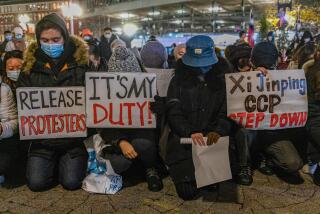Wreath in Beijing Square Ushers in Tense Period : China: Authorities fear another outbreak of protest during a series of politically sensitive anniversaries.
- Share via
BEIJING — A wreath honoring the spirits of the dead was placed at the foot of the Monument to the People’s Heroes in Tian An Men Square on Saturday and allowed to remain there throughout the day.
The action, while its purpose and significance remained unclear, marked the beginning of a tense season of politically sensitive anniversaries that has much of Beijing in a state of uneasy anticipation.
The square was the center of last spring’s massive pro-democracy demonstrations, which ended with hundreds, perhaps thousands, of deaths when soldiers were ordered into the city to forcibly suppress the protests.
Anger among Beijing citizens is still widespread. But any open protest is extremely dangerous, for authorities have beefed up security, including the stationing of thousands of paramilitary police near the square. Saturday afternoon, two columns of these police, each consisting of about 125 men, reminded citizens of their presence by chanting and marching along the east side of the square.
While China’s political leaders insist that the country is basically united and stable, there have been various indications that authorities fear another outbreak of protest.
This spring “may be an extremely unstable period,” Li Qiyuan, deputy secretary of the Beijing City Communist Party organization, said late last month in remarks quoted by the official newspaper Beijing Legal News.
In recent weeks, pro-democracy activists overseas have bombarded facsimile machines and mailboxes in Beijing with letters calling for “walks” in Tian An Men Square today and Thursday. Thursday is the Qingming Festival, the traditional day of grave-sweeping and mourning for the dead.
“We don’t want to carry banners with slogans,” said one typical letter, which claimed to be from Beijing citizens and students but was mailed from Singapore to a Beijing-area university. “We just need to walk about naturally in the square. We can chat with each other, we can sing and dance, we can feel happy or feel sorrowful. We also can merely be quiet. . . . It’s only necessary for thousands or tens of thousands of people to stand on Tian An Men Square, and it will become the focal point of the world’s attention. Everyone can fully understand the entire meaning and significance of a peaceful crowd in the square.”
The letter described such gatherings in the square as only the first step in trying to build an escalating wave of protests.
In recent weeks, according to Chinese who have spoken to foreigners, many workplaces in Beijing have told their employees to stay away from the square on these dates, as well as anniversaries of key dates in last year’s protests. The last and most important of these anniversaries is June 4, the date of last year’s massacre.
But Beijing Mayor Chen Xitong, a hard-liner who played a key role in calling for last year’s military crackdown, told reporters Friday that he knew nothing about restrictions on visits to the square.
“Everyone is allowed to take a walk anywhere,” Chen said.
A European diplomat, who expressed surprise that the wreath was allowed to remain in the square Saturday, said it is hard to believe that this was an act of open protest. He speculated that government hard-liners may have decided to allow memorial activities for revolutionary martyrs in order to be able to cite this as the reason for any unusually large crowds.
The wreath and an adjacent display of paper flowers placed at the monument in the square Saturday carried nothing specific about whom or what they were meant to honor. The wreath carried small white banners saying “Eternal Glory to the People’s Heroes” and “Salute the People’s Heroes.” In the middle of the wreath was a single large Chinese character that means “make offerings to the spirits of the dead.” Both displays were labeled as coming from suburban Beijing elementary schools.
A paramilitary police officer on guard near the base of the monument, asked whether such displays of wreaths were permitted, paused for a moment, then said firmly: “Yes. It is permitted.”
Throughout the day, crowds ranging from a few dozen to a few hundred gathered to gaze at the wreath and flower display. Several thousand people strolled through the huge square, many taking family photographs and some flying kites. At nightfall, the base of the monument was roped off, keeping viewers about 75 feet away from the wreath.
This morning, the main part of the square was closed to ordinary pedestrians. Instead, thousands of schoolchildren wearing yellow caps and red kerchiefs arrived for a ceremony at the monument.
If citizens are allowed to place wreaths at the monument in coming days, this could have unpredictable consequences.
Last spring, it was the pretext of mourning for Hu Yaobang, a reformist former Communist Party chief, that enabled demonstrators to develop the momentum that ultimately led to the pro-democracy protests.
On April 5, 1976, the removal of wreaths placed in mourning for Premier Chou En-lai led to a massive protest and rioting in Tian An Men Square. That in turn led to the downfall, later that year, of Chairman Mao Tse-tung’s widow, Jiang Qing, and her radical allies in the so-called Gang of Four.
“This is the first manifestation of something of this kind on a very long list of possible dates for (protest) events,” commented the European diplomat, who spoke on condition of anonymity. “But I really think it’s too early to say anything about what it means.”
More to Read
Sign up for Essential California
The most important California stories and recommendations in your inbox every morning.
You may occasionally receive promotional content from the Los Angeles Times.













